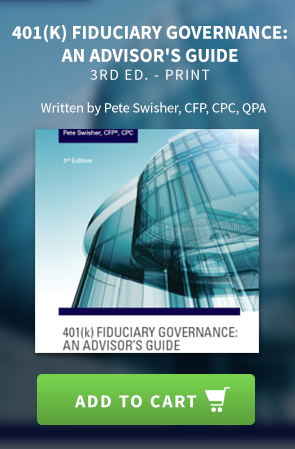Industry Trends & Research
The Congressional Research Service (CRS) has provided an overview concerning the Social Security full retirement age (FRA) and what changes to it mean. This is especially timely since the effects of adjustments made under a reform measure enacted in 1983 are kicking in.
About the FRA
A worker’s...
READ MORE
Employee participation in retirement plans could be better, by some measures. How to improve it has long been a topic of discussion — and knowing what employees are looking for in a plan is a key factor in bringing that about.
It’s the Economy, S_____
What employees want can be a bit of a moving...
READ MORE
Comparisons between public- and private-sector benefits are understandable; indeed, such comparisons are often a large factor in employment decisions. But the variety and types of employers — and workers — covered by programs that operate under the auspices of 403(b) plans are extraordinarily...
READ MORE
It may be winter, but the heat continues for CalSavers. The CalSavers Retirement Savings Board, which administers CalSavers, reports that the program continues to grow. In fact, growth in January outstripped that of December regarding total assets and average funded account balance.
CalSavers,...
READ MORE
OregonSaves, CalSavers, Illinois Secure Choice…call it what you will, they and their counterparts boil down to one basic thing — a retirement plan sponsored by the state government to provide at least some kind of retirement plan coverage for individuals who lack access to one. In most cases, that...
READ MORE
An exodus of teachers could be looming — but retirement benefits offer a way to head that off, a recent report suggests.
Almost two-thirds of U.S. educators — 63% — are at least considering leaving the teaching profession, say Horace Mann National Business Solutions Executive Kelly Ruwe and...
READ MORE
When asked how long people typically live in retirement, more than half of adult Americans were unable to answer the question correctly in an annual survey, writes Ted Godbout in MarketBeat. He continues that this is a crucial knowledge gap that could interfere with saving enough to last through...
READ MORE
Enactment of the SECURE 2.0 Act, ongoing industry innovations, and the aim to provide greater personalization are among the many opportunities that plan sponsors have to align DC plan features, practices and investments with participant needs.
Indeed, the need for greater personalization of the...
READ MORE
Despite a rebound in out-of-pocket health care spending in 2021, health savings account (HSA) balances increased on average over the course of the year, the Employee Benefit Research Institute (EBRI) recently found.
Its analysis of HSA balances, contributions, and distributions, also found, “...
READ MORE
More public-sector employees have access to retirement plans than their counterparts in private industry, reports the Bureau of Labor Statistics (BLS). Same is true regarding participation.
In its Feb. 1, 2023 The Economics Daily, the BLS provides a snapshot of access to, and participation in,...
READ MORE
In the face of prolonged economic uncertainty and volatility, many investors are rethinking what life after retirement may look like and are adjusting their priorities accordingly.
According to Nationwide Retirement Institute’s eighth annual Advisor Authority, nearly 7 in 10 (69%) non-retired...
READ MORE
The parties in one of the first university 403(b) excessive fee suits — by participant-plaintiffs represented by the Schlichter law firm — has come to terms on the eve of going to trial.
The suit, filed in August 2016, involved two plans sponsored by the University of Southern California (the...
READ MORE
SECURE 2.0 is a reality now — and two industry experts offered their insights in a Jan. 25 webcast as the dust settles.
American Retirement Association Director of Regulatory Affairs Kelsey Mayo, who also is a Partner at Poyner Spruill LLP, and American Retirement Association Director of...
READ MORE
Editor’s note: This the second in a four-part series. The original appears in its entirety as the cover story of the Winter 2023 edition of Plan Consultant magazine. The digital edition of the Winter issue is available here. However, access to Plan Consultant is restricted to ASPPA members, so you’...
READ MORE
A new report reveals that individual retirement account (IRA) assets reached nearly $14 trillion in 2021, thanks in large part to rollovers from defined contribution (DC) plans.
According to The Cerulli Report — U.S. Retirement Markets 2022: The Role of Workplace Retirement Plans in the War for...
READ MORE
The findings of a new survey suggest that plan sponsors and professionals should be proactive in providing education and advice, as most near-retirees indicate they are looking for help to maximize retirement benefits while minimizing taxes.
According to Allspring Global Investments’ 20th annual...
READ MORE
Editor’s note: This the first in a four-part series. The original appears in its entirety as the cover story of the Winter 2023 edition of Plan Consultant magazine. The digital edition of the Winter issue is available here. However, access to Plan Consultant is restricted to ASPPA members, so you’...
READ MORE
While the long-term economic impact of the pandemic remains unclear, one thing that is clear is the highest inflation in decades has forced many Americans to reevaluate their retirement saving habits.
This is according to a new survey from U.S. News & World Report’s 360 Reviews revealing that...
READ MORE
A high-stakes game of political chicken is set to come to a head this week, as the country will reach its $31.381 trillion debt limit on Thursday.
The debt limit is the total amount of money the United States government is authorized to borrow to meet its existing legal obligations, including...
READ MORE
It is a growing club that no one wants to join: the club of companies that became victims of cyberterrorism. In MarketBeat, Alison J. Cohen writes that it is often not a question of “if” a company will be attacked, but “when,” and that her firm is being asked what one should do about that.
READ MORE


